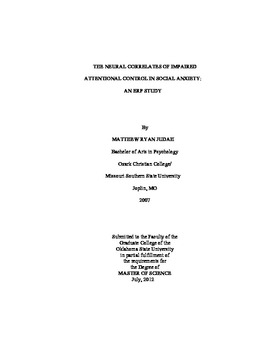| dc.description.abstract | Cognitive models of social anxiety disorder posit that cognitive processes associated with social anxiety, such as self-focused attention, influence behaviors in feared social environments. However, these models are relatively nonspecific about the effects and basic mechanisms of this process. The current study drew from attentional control theory in order to provide specific predictions, namely, that anxiety interferes with processing efficiency, particularly in the executive control processes of inhibition and shifting. The current study tested whether socially anxious individuals demonstrated impaired processing efficiency at the neural and behavioral level, and whether this was exacerbated by a manipulation of self-focused attention. Thirty-two (16 socially anxious, 16 non-anxious controls) subjects completed a mixed-antisaccade task with a circle which appeared around the instructional cue on 20% of trials. Participants were told that this circle indicated elevated heart rate. Eye-movements were measured using horizontal electrooculography, and event-related brain potentials were derived from EEG data collected during the task. Socially anxious individuals reported that the heart rate feedback made them more self-conscious and interfered more with their performance on the task compared to controls. The socially anxious group also demonstrated impaired processing efficiency as indicated by delayed onset of correct saccades compared to controls, but made fewer errors. Additionally, socially anxious individuals had lower P3b amplitude compared to controls, suggesting greater effort in discriminating cues, and later P3b latency for trials on which heart rate feedback was present, suggesting delayed cue categorization. Furthermore, socially anxious individuals had greater CNV negativity compared to controls, suggesting greater recruitment of attentional resources for response preparation, and later onset of this component, suggesting delayed response preparation. These results were as hypothesized and are generally consistent with attentional control theory. The current study supports the applicability of this model for cognitive theories of social anxiety and expands these theories by providing evidence of impaired neural and behavioral functioning in social anxiety, especially as a result of self-focused attention. | |
